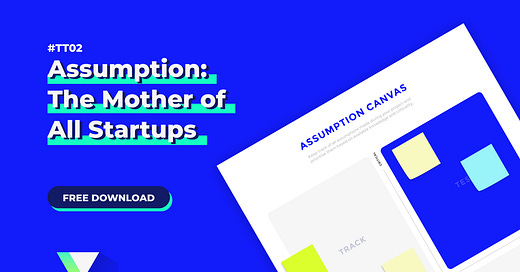Assumption: The Mother of All Startups (#TT02)
Launch with confidence and avoid unnecessary risk.

This post is part of an ongoing series about Startup Validation called Testing Tuesdays.
Gain the edge with the hacks, tools and smarts to build start ups the right way early by subscribing below:
My first boss kept telling me:
"Assumption is the mother of all F-ups."
In my eyes, that was only true if you:
A. Make the wrong assumptions.
B. Do not validate your assumptions before putting them into practice.
Both of which he did plenty of.
Of course, the only way to know if your assumptions are wrong, is to put them to the test. Which is why in this week's Testing Tuesdays we'll explore how to capture and prioritise assumptions (and experiments).

What is an assumption?
An assumption is an expected outcome of a business idea.
EXAMPLE:
You're exploring the idea for an organic baby food subscription service like Little Spoon. Some of the many assumptions you might make are:
People are aching for a baby food subscription.
You can develop packaging that is safe for both the baby and the environment.
You can keep the supply chain short enough to preserve the food until consumption.
Assumptions are the answer to the question: What do we need to prove to bet on startup success?
Whenever you act on a business idea, you are making a bet.
Validating business ideas is about reducing the risk of your bets. Make no mistake: They will still be bets, but they will be educated.

An assumption is an assumption until it is (in)validated by scientific or empirical evidence.
The Four Core Innovation Assumptions
Building a startup is nothing more than a series of tests to prove four things:
Desirability: Do people really, really want this product?
Viability: Can we really, really make money with this product?
Feasibility: Are we really, really sure we can build this product?
Responsibility: Are we really, really making the world a better place with this product?
Let's call these the Four Core Innovation Assumptions. Every assumption can be dumbed down to one of these four.
If an innovation team can prove these four things, that pretty much counts as startup success.
In practice, things usually aren't that simple however. Startups are about speed to market. You will make a multitude of assumptions along the way, and want to gather as much evidence as possible, with the least amount of resources.

Introducing: The Assumption Canvas
The Assumption Canvas is a pretty simple tool that helps prioritise assumptions.
With it you will be able to filter out just the 'critical unknown assumptions' – the ones that carry the largest risk.
Let me explain how to use it:
1. Keep track of all assumptions.
Validation happens one level at a time. Slap all post-it for each assumption made on a certain level on the center of the canvas. Don't worry about prioritisation just yet, that comes next.
Write down your assumptions using the phrase: "We believe that..."
EXAMPLE:
Little Spoon: "We believe that shopping for and preparing baby food is a major hassle for parents."
Fortnite: "We believe that we can monetise a free video game using virtual cosmetics only."
The Park: "We believe that at home VR adoption is too low to be commercially interesting."

Bonus points if you use a different colour of post-it based on the Four Core Innovation Assumptions.
2. Prioritise Your Assumptions
The Assumption Canvas has two axes...:
Known – Unknown, and
Critical – Non-Critical
...that split the canvas in four.
For every assumption that was put on the canvas in the previous step, ask yourself:
Is the assumption known?
An assumption is known if evidence of it being true is readily available. If evidence is a Google search away, treat it as being known.Is the assumption critical?
An assumption is critical if evidence against it would result in a major pivot or even killing the idea. This is a qualitative estimation made by the team members.
Rearrange the post-its with the assumptions based on your answers to the above questions.

3. Test, Track, Trace, or Toss
Every assumption should now land in one of the four quadrants. The quadrant tells us how to treat the assumption from now on:
TEST the critical unknown assumptions using one or more validation experiments.
TRACK the critical known assumptions over time, in case the data changes or new knowledge arises.
You may want to TRACE the non-critical unknown assumptions in the future, so document them somewhere for now.
TOSS the non-critical known assumptions.
Congrats! You now know exactly what to test 🎉. Grab your free canvas and get testing.
Thanks for reading! 🙏🏻
Want to get the tools, hacks & smarts to build startups the right way?
Subscribe to get my newsletter straight in your inbox:
If you feel the need to reciprocate, feel free to share, leave a like, or buy me a coffee ❤️.



